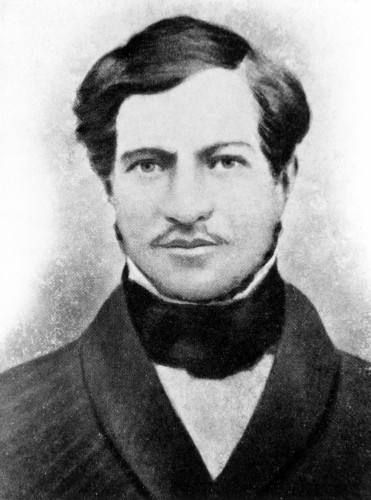South Coast NSW History Story
Syms Covington
Syms Covington (1814 – 1861)
Syms (Simon) Covington, along with his (then) three sons and his wife, arrived in Pambula some time between 1844 and 1846. It is assumed he had been invited to the area by retired Royal Naval Captain John Lloyd who had acquired land in the Pambula area using his severance pay from the Navy.
Covington became the second Postmaster at Pambula and built the Forest Oak Inn (now a National Trust-listed building, ‘Covington’s House,’ located just down from the shops in Quondola Street). He became a property owner, buying large tracts of land around Pambula and several blocks in Eden.
His real place in history, though, pre-dates his move to the NSW South Coast.
In 1831, when just 17 years old, Syms Covington became ‘fiddler & boy to Poop-cabin’ on HMS Beagle for a survey voyage to South America under the command of Capt. Robert FitzRoy. Charles Darwin subsequently joined that voyage as a self-funded naturalist.
In 1833 Covington became Charles Darwin’s servant, after Charles wrote to his father asking him to pay Covington’s wages and expenses: ‘I am rather badly off for anyone to wait on me. The man (Covington) is willing to be my servant, & ALL the expences would be under £60 per annum. I have taught him to shoot & skin birds, so that in my main object (working as a naturalist) he is very useful.’ (Hence the title of the novel, based on Syms Covington’s life, by Roger McDonald and published in 2000, ‘Mr Darwin’s Shooter.’)
Covington and Darwin visited Sydney in 1836, collecting ninety-two different species of insects, thirty-one previously unknown to science. Covington wrote ‘The Harbour I think is the finest & most beautiful I have yet seen’ but also wrote that Sydney was a place consisting 'princibly of convicts, or the most notorious characters of England – & a place I must say I was heartily glad to leave.’ This is a somewhat interesting observation, considering that Covington moved to Sydney several years later!
Covington was to remain in Darwin’s employ until 1839 when he decided to emigrate to New South Wales. Darwin provided him with references to William Sharp Macleay (another naturalist, who was to become Trustee of the Australian Museum), Capt Phillip Parker King (an explorer and surveyor, and son of NSW Governor Phillip Gidley King) and Thomas Mitchell (Surveyor General of NSW), plus an open letter of introduction.
Covington and Darwin remained firm friends throughout their lives and corresponded regularly. In one letter Darwin wrote ‘You have an immense, incalculable advantage in living in a country in which your children are sure to get on if industrious. I assure you that, though I am a rich man, when I think of the future I very often ardently wish I was settled in one of our Colonies, for I now have four sons (seven children in all, and more coming) and what on earth to bring them up to, I do not know…Many people think that Californian gold will half ruin all those who live on the interest of accumulated gold or capital, and if that does happen I will certainly emigrate. Whenever you write again, tell me how far you think a gentleman with capital would get on in New South Wales…’
Darwin also wrote to Covington: ‘I do not know whether you live near the sea, but if so I would be very glad if you would collect me any barnacles that adhere (small and large) to the coast rocks or to shells or to corals thrown up by gales, and send them to me without cleaning out the animals, and taking care of the bases.’ In response to this request, Covington and his eldest son collected a large number of barnacles which Darwin acknowledged, indicating that one proved to be ‘a new species of a genus of which only one specimen is known to exist in the world.’
Covington gradually lost his hearing (reputedly the result of shooting for specimens for Darwin!), so in March 1850 Charles Darwin sent him a ‘new ear trumpet… I was not able to send it sooner. You must accept it as a present from me. I presume you will have to pay a trifle for carriage,’ along with instructions on how to repair his existing ear-trumpet.
Darwin had obviously also been consulted by Covington about using the services of an Aurist (a person (supposedly) skilled in treating and curing disorders of the ear), with Darwin advising: ‘As to the Aurist, you may rely on it that the man is an advertising humbug. I know plenty of people, and have one relation, very deaf, and everyone in London would know if this man's power of curing is true. My father, who was a very wise man, said he had known numbers who had been injured by Aurists, and none who had benefited. A common good surgeon can do all that these humbugs can do. I am very sorry to hear about your deafness increasing, it is a very great misfortune for you, but I fear you must look at it as incurable.’
Syms Covington died of 'paralysis’ (i.e. probably a stroke) on 19 February 1861, aged forty-seven. He was/is buried in Pambula Cemetery, his tombstone (significantly) recording that he was Darwin’s assistant on the Beagle.
